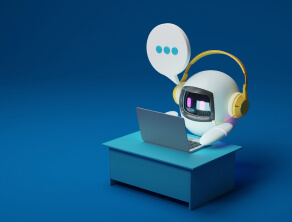How Chatbots Are Ushering In A New Revolution In Enterprises

Chatbots are simple text based services powered with artificial intelligence and designed to interact via a chat interface. This can be used as for functional or fun purposes like virtual assistant siri, Cortana etc.
Currently, chatbots are very popular in the consumer space. From the business perspective, e-commerce, delivery and transportation businesses boost their business opportunities by letting their end users order goods and services even more conveniently.
But if you look very closely, you will see that bots are slowly taking over the enterprise space as well.
Industry observers say, momentum for chatbots is growing as companies seek to improve services on top of the data that’s available to them. Companies from KLM Airlines to Taco Bell, Sephora, Expedia and Whole foods among others, have all rolled out chatbots to let users order food, book flights, inquire about services and browse online stores.
How Can Chatbots Generate Value And Enhance The ROI?
Chatbots would enormously improve the user experience for both your customers and your team when it comes to CRM, for instance. An extension or third-party service could speed up and automate data entry, preventing data leakage in the process. ‘Slackbots’ like Troops connect CRM software with Slack, easily pushing and pulling data with the goal of allowing Slack to become the communications hub for your sales team, letting them interact with each other and the CRM through the same chat interface quickly and efficiently.
Chatbots and Digital Transformation
So what do you need in order to start being able to gain some of the competitive benefits that chatbots can offer?
There are numerous ways this can be approached and it does not have to mean all or nothing.The increasing popularity of messaging and broad trend towards chat interfaces being the user preference means that this is a significant shift. However, savvy organisations looking to increase their ROI are already engaged in wide-ranging digital transformation, representing the growing importance of digital in enterprise and in the world in general. If you are in this category, you are already building strong digital foundations and developing a flexible digital strategy. This will certainly encompass some of the prerequisites for taking advantage of the emerging chatbot revolution.
Challenges
Companies should be able to make the interfaces work much better — and that has huge implications as it will help them to interact with customers. To succeed, however, they’ll need to overcome a number of challenges.
- Natural language processing: Right now, chatbots require us to master their syntax. If you ask them “What’s the weather?” you’ll usually get an answer. If you ask “Could you check the weather?” you might not. To get around this problem, companies need to enable bots to understand all the ways we say something — and how context changes what we mean. This is known as natural language processing, and it’s an object of considerable focus for companies like Google, with SyntaxNet, and Facebook, with its DeepText A.I.
- Machine learning: To get truly natural responses, companies need to improve machine learning. With exposure to enough conversations, the computer on the other end of the line should slowly learn what the correct response should be. Of course, the challenges involved are far from simple, as illustrated by Microsoft’s short-lived experiment with its unintentionally racist chatbot Tay.
- Providing value: Companies have to figure out what they can offer through A.I. The possibilities here are great. If Uber recognizes the right time to offer a taxi, why can’t banks recognize and facilitate money transfers between friends?
- Human intelligence: The technologies themselves are only as capable as the programmers who build them. This reflects a larger trend in which digital players are shifting their focus from traditional engineers to machine-learning experts. Rather than teaching humans to understand machines, we’re now teaching machines to understand us.
- Staying simple: It might seem like a “natural” chatbot needs to be infinitely vast in order to succeed. That’s not true. Most successful innovations, like iOS, are simple and easy to use. For companies to succeed, they’ll need to look for the least common denominator in their services.
- Preparing an exit: This means companies also need to hand the experience off at some point. Currently, chat-like services such as Siri and Alexa have mixed track records when it comes to solving this problem. Most of the time, when they don’t understand you, they simply take your text and turn it into a web search. With intelligent A.I., we’ll need an elegant way to send people to a system that can understand them when they’ve exhausted our possibilities.
- The Future: Chatbots are like toddlers in the enterprise world who are trying to speak their first words, but businesses are confident that bots will be here to stay. With further developments in the bot space and the use of technologies like artificial intelligence, chatbots are expected to become more intelligent. Right now, intelligent chat is still a little ways off. But with work moving forward on all fronts, companies need to start thinking about what they can do with these new technologies. It’s time to keep an ear to the ground and start working on the future.
Tags: chatbot
![Blog-[x]cube LABS](https://d6fiz9tmzg8gn.cloudfront.net/wp-content/uploads/2016/06/blog_banner.jpg)



